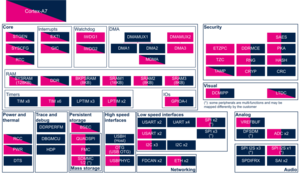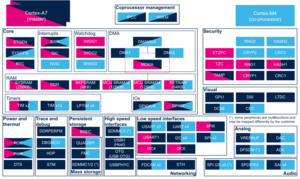Registered User mNo edit summary Tag: 2017 source edit |
Registered User mNo edit summary Tag: 2017 source edit |
||
| Line 80: | Line 80: | ||
{{#lst:STM32MP2_internal_peripherals_assignment_table_template|stm32mp2_a35_boottime}} | {{#lst:STM32MP2_internal_peripherals_assignment_table_template|stm32mp2_a35_boottime}} | ||
<section begin=stm32mp21_a35_boottime /> | <section begin=stm32mp21_a35_boottime /> | ||
| rowspan=" | | rowspan="1" | Security | ||
| rowspan=" | | rowspan="1" | [[HASH internal peripheral | HASH]] | ||
| HASH1 | | HASH1 | ||
| <span title="system peripheral" style="font-size:21px">✓</span> | | <span title="system peripheral" style="font-size:21px">✓</span> | ||
Revision as of 11:18, 7 November 2024
1. Peripheral overview[edit | edit source]
The HASH peripheral is used to compute a message digest.
The HASH peripheral is also able to give the HMAC[1] used for authentication using the same algorithm support.
1.1. On STM32MP13x lines  and STM32MP2 series[edit | edit source]
and STM32MP2 series[edit | edit source]
Secure Hash algorithms supports:
- SHA-1 [2]
- SHA-2 [3]:
- SHA-224
- SHA-256
- SHA-384
- SHA-512
- Truncated output SHA-512/224, SHA512/256
- SHA-3 [4]:
- SHA3-224
- SHA3-256
- SHA3-384
- SHA3-512
- SHAKE128 and 256
- Keccak-based functions
- HMAC support for all supported algorithm
Refer to the STM32 MPU reference manuals for the complete list of features, and to the software frameworks and drivers, introduced below, to see which features are implemented.
1.2. On STM32MP15x lines  [edit | edit source]
[edit | edit source]
Secure Hash algorithms supports:
Refer to the STM32MP15 reference manuals for the complete list of features, and to the software frameworks and drivers, introduced below, to see which features are implemented.
2. Peripheral usage[edit | edit source]
This chapter is applicable in the scope of the OpenSTLinux BSP running on the Arm® Cortex®-A processor(s), and the STM32CubeMPU Package running on the Arm® Cortex®-M processor.
2.1. Boot time assignment[edit | edit source]
The HASH instance is used as boot device to support binary authentication when device is in secured locked state.
2.1.1. On STM32MP13x lines  [edit | edit source]
[edit | edit source]
Click on ![]() to expand or collapse the legend...
to expand or collapse the legend...
| Domain | Peripheral | Boot time allocation | Comment | |||
|---|---|---|---|---|---|---|
| Instance | Cortex-A7 secure (ROM code) |
Cortex-A7 secure (TF-A BL2) |
Cortex-A7 non-secure (U-Boot) | |||
| Security | HASH | HASH | ✓ | ☑ | ||
2.1.2. On STM32MP15x lines  [edit | edit source]
[edit | edit source]
Click on ![]() to expand or collapse the legend...
to expand or collapse the legend...
| Domain | Peripheral | Boot time allocation | Comment | |||
|---|---|---|---|---|---|---|
| Instance | Cortex-A7 secure (ROM code) |
Cortex-A7 secure (TF-A BL2) |
Cortex-A7 non-secure (U-Boot) | |||
| Security | HASH | HASH1 | ✓ | ☑ | ||
| HASH2 | not used at boot time. | |||||
2.1.3. On STM32MP21 unknown microprocessor device[edit | edit source]
Click on ![]() to expand or collapse the legend...
to expand or collapse the legend...
| Domain | Peripheral | Boot time allocation | Comment | |||
|---|---|---|---|---|---|---|
| Instance | Cortex-A35 secure (ROM code) |
Cortex-A35 secure (TF-A BL2) |
Cortex-A35 non-secure (U-Boot) | |||
| Security | HASH | HASH1 | ✓ | ☑ | ☐ | |
2.1.4. On STM32MP23 unknown microprocessor device[edit | edit source]
Click on ![]() to expand or collapse the legend...
to expand or collapse the legend...
| Domain | Peripheral | Boot time allocation | Comment | |||
|---|---|---|---|---|---|---|
| Instance | Cortex-A35 secure (ROM code) |
Cortex-A35 secure (TF-A BL2) |
Cortex-A35 non-secure (U-Boot) | |||
| Security | HASH | HASH | ✓ | ☑ | ☐ | |
2.1.5. On STM32MP25x lines  [edit | edit source]
[edit | edit source]
Click on ![]() to expand or collapse the legend...
to expand or collapse the legend...
| Domain | Peripheral | Boot time allocation | Comment | |||
|---|---|---|---|---|---|---|
| Instance | Cortex-A35 secure (ROM code) |
Cortex-A35 secure (TF-A BL2) |
Cortex-A35 non-secure (U-Boot) | |||
| Security | HASH | HASH | ✓ | ☑ | ☐ | |
2.2. Runtime assignment[edit | edit source]
2.2.1. On STM32MP13x lines  [edit | edit source]
[edit | edit source]
Click on ![]() to expand or collapse the legend...
to expand or collapse the legend...
| Domain | Peripheral | Runtime allocation | Comment | ||
|---|---|---|---|---|---|
| Instance | Cortex-A7 secure (OP-TEE) |
Cortex-A7 non-secure (Linux) | |||
| Security | HASH | HASH | ☐ | ☐ | Assignment (single choice) |
2.2.2. On STM32MP15x lines  [edit | edit source]
[edit | edit source]
Click on ![]() to expand or collapse the legend...
to expand or collapse the legend...
| Domain | Peripheral | Runtime allocation | Comment | |||
|---|---|---|---|---|---|---|
| Instance | Cortex-A7 secure (OP-TEE) |
Cortex-A7 non-secure (Linux) |
Cortex-M4 (STM32Cube) | |||
| Security | HASH | HASH1 | ☐ | ☐ | Assignment (single choice) | |
| HASH2 | ☐ | |||||
2.2.3. On STM32MP21 unknown microprocessor device[edit | edit source]
| rowspan="2" | Security | rowspan="2" | HASH | HASH1 | ☐OP-TEE | ☐ | ☐ | ☐ | |- | HASH2 | ☐OP-TEE | ☐ | ☐ | ☐ | |-
|}
2.2.4. On STM32MP23 unknown microprocessor device[edit | edit source]
| rowspan="1" | Security | rowspan="1" | HASH | HASH | ☐OP-TEE | ☐ | ☐ | ☐ | |-
|}
2.2.5. On STM32MP25x lines  [edit | edit source]
[edit | edit source]
Click on ![]() to expand or collapse the legend...
to expand or collapse the legend...
| Domain | Peripheral | Runtime allocation | Comment | |||||
|---|---|---|---|---|---|---|---|---|
| Instance | Cortex-A35 secure (OP-TEE / TF-A BL31) |
Cortex-A35 non-secure (Linux) |
Cortex-M33 secure (TF-M) |
Cortex-M33 non-secure (STM32Cube) |
Cortex-M0+ (STM32Cube) | |||
| Security | HASH | HASH | ☐OP-TEE | ☐ | ☐ | ☐ | ||
3. Software frameworks and drivers[edit | edit source]
Below are listed the software frameworks and drivers managing the HASH peripheral for the embedded software components listed in the above tables.
- Linux®: crypto framework
- OP-TEE: HASH driver and Cryptographic Provider API (CP API)
- STM32Cube: HASH HAL driver and header file of HASH HAL module
- TF-A BL2: HASH driver
4. How to assign and configure the peripheral[edit | edit source]
The peripheral assignment can be done via the STM32CubeMX graphical tool (and manually completed if needed).
This tool also helps to configure the peripheral:
- partial device trees (pin control and clock tree) generation for the OpenSTLinux software components,
- HAL initialization code generation for the STM32CubeMPU Package.
The configuration is applied by the firmware running in the context in which the peripheral is assigned.
5. References[edit | edit source]


